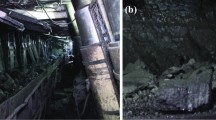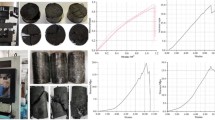Abstract
In view of the fact that rib spalling of coalfaces seriously affects normal production in a large-cutting-height panel, the mechanical model of the “coalface–support-roof” is established to analyze the main factors affecting coalface stability, and a real panel, no. 8101, is used as an example. Using the main influence factors with different levels, orthogonal experimental design is used to determine the numerical simulation scenarios. The coalface failure conditions for different simulated scenarios are studied using DEM method. The orthogonal experiment method was used to analyze the simulation results in this study. The coalface is strengthened using the “manila+ grouting” reinforcement technique. The results show that the factors affecting coalface stability are the cutting height, support capacity, coal cohesion, coal friction, and upward-inclined angle. The larger the cutting height is, the larger the roof pressure is on the coalface. The larger the support capacity is, the smaller the roof pressure is on the coalface. The larger the coal cohesion and friction values are, the larger the roof pressure is that the coalface can bear. The sensitivities of cutting height, support capacity, coal cohesion, coal friction, and an upward-inclined angle with respect to coalface stability are 14.60, 2.29, 38.63, 1.19, and 1.95, respectively. In descending order of influence, the factors are coal cohesion ˃ cutting height ˃ support capacity ˃ upward-inclined angle ˃ coal friction. The “manila+ grouting” reinforcement technology effectively controls coalface failure, yields a 30~40% saving in costs, and reduces incidents of coalface failure by 70~80%. The research results provide new insights for the evaluation and control of coalface stability.








Similar content being viewed by others
References
Barla M, Beer G (2012) Special issue on advances in modeling rock engineering problems. Int J Geomech 12(6):617–617
Basarir H, Oge IF, Aydin O (2015) Prediction of the stresses around main and tailgates during top coal caving by 3D numerical analysis. Int J Rock Mech Min Sci 76:88–97
Bicanic N (2004) Discrete element methods. In: Stein E, De Borst R, Hughes TJR (eds) Encyclopedia of computational mechanics. 1. Wiley. ISBN 0-470-84699-2
Cundall PA, Strack ODL (1979) A discrete numerical model for granular assemblies. Géotechnique 29(1):47–65. https://doi.org/10.1680/geot.1979.29.1.47
Graziani A, Rossini C, Rotonda T (2012) Characterization and DEM modeling of shear zones at a large dam foundation. Int J Geomech 12(6):648–664
Hao H-j, Zhang Y (2005) Stability analysis of coal wall in full-seam cutting workface with fully-mechanized in thick seam. J Liaoning Tech Univ 04:27–29
Itasca (2004) UDEC - Universal Distinct Element Code, ver. 4: Itasca Consulting Group Inc
Jeromel G, Medved M, Likar J (2010) An analysis of the geomechanical processes in coal mining using the Velenje mining method. Acta Geotech Slov 7:31–45
Karekal S, Das R, Mosse L, Cleary PW (2011) Application of a mesh-free continuum method for simulation of rock caving processes. Int J Rock Mech Min Sci 48(5):703–711
Likar J, Medved M, Lenart M (2012) Analysis of geomechanical changes in hanging wall caused by longwall multi top caving in coal mining. J Min Sci 48:135–145
Liu C-y, Huang B-x, Chang X-m et al (2008) Study on tip to face coal and rock stability control of fully mechanized stepped large cutting height mining in extremely soft thick seam. J China Univ Min Technol 37(6):734–739
Liu R, Zhang Y, Wen C et al (2010) Study on the design and analysis methods of orthogonal experiment. Exp Technol Manag 27(9):52–55
Liu W, Liu S, Ji B (2015) Sensitivity analysis of controlling factors on failure depth of floor based on orthogonal experiment. J China Coal Soc 40(9):1995–2001
Vakili A, Hebblewhite BK (2010) A new cavability assessment criterion for longwall top coal caving. Int J Rock Mech Min Sci 47(8):1317–1329
Wang J-c (2007) Mechanism of the rib spalling and the controlling in the very soft coal seam. J China Coal Soc 32(8):785–788
Wang J-c (2009) The mining theory and technique of thick coal seam. Metallurgical Industry Press, Beijing
Wang J, Yang Y, Kong D et al (2014) Failure mechanism and grouting reinforcement technique of large mining height coal wall in thick coal seam with dirt band during topple mining. J Min Saf Eng 31(6):831–837
Wang J, Wang Z, Kong D (2015) Failure and prevention mechanism of coal wall in hard coal. J China Coal Soc 40(10):2243–2250
Wang J, Yang S, Kong D (2016) Failure mechanism and control technology of longwall coal face in large-cutting-height mining method[J]. Int J Min Sci Technol 26(1):111–118
Williams JR, Hocking G, Mustoe GGW (1985) The theoretical basis of the discrete element method. NUMETA 1985, Numerical methods of engineering, theory and applications. A.A. Balkema, Rotterdam
Yan S-h (2008) Research on side and roof falling mechanism and control approaches in full-mechanized caving mining with large mining height. Coal Min Technol 13(04):10–13
Yang S, Kong D (2015) Flexible reinforcement mechanism and its application in the control of spalling at large mining height coal face. J China Coal Soc 40(6):1361–1367
Yang P-j, Liu C-y, Wu F-f (2012) Breakage and falling of a high coal face in a thick mined seam. J China Univ Min Technol 41(03):372–377
Yuan Y, Tu S-h, Ma X-t et al (2012) Coal wall stability of fully mechanized working face with great mining height in “three soft” coal seam and its control technology. J Min Saf Eng 29(1):22–25
Zhao H-z (1989) The control and mechanism of rib spalling in large mining face. Mine Pressure 02:27–29
Acknowledgments
We acknowledge the National Natural Science Foundation of China Youth Fund (No. 51904082) and the annual academic training and special innovation program of Guizhou University in 2018 (Guizhou Kehe [2018]5781-26) and the Youth Science and Technology Talents Development Project of Guizhou Education Department (Guizhou Education Co-operation KY character [2018] 114).
Funding
This work was financially supported by the Scientific Research Foundation of Guizhou Provincial Department of Science and Technology and Guizhou University (QianKehe LH [2017]7280) and the Key Laboratory of Safety and High-efficiency Coal Mining, Ministry of Education (JYBSYS2017101).
Author information
Authors and Affiliations
Corresponding author
Additional information
Editorial handling: Murat Karakus
Rights and permissions
About this article
Cite this article
Kong, D., Liu, Y. & Zheng, S. Sensitivity analysis of influencing factors and control technology for coalface failure. Arab J Geosci 12, 550 (2019). https://doi.org/10.1007/s12517-019-4714-4
Received:
Accepted:
Published:
DOI: https://doi.org/10.1007/s12517-019-4714-4




